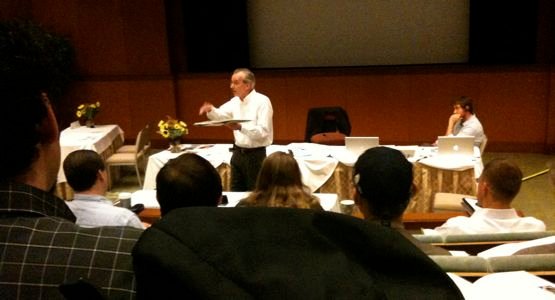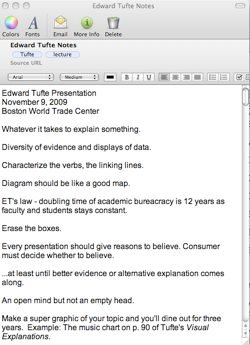
Edward Tufte, Yale professor emeritus and information design guru, sets a high but liberating standard. One must do “whatever it takes” to explain something. Including him.
Why I Went: I noticed somewhere on the Internet a couple of years ago that Edward Tufte was generating cult-like devotion among those who had attended his all-day presentations. I made a note to attend one in Denver or Boston, if the chance arose. So on Monday, November 9, 2009, I found myself at the World Trade Center in Boston, watching a fit, wiry man in his 60s puttering around tables adorned with two vases of flowers and two Macintosh laptop computers at the front of an auditorium. He was waiting for the room to fill with people who had paid $380 each to hear him explain a few things. By then I had forgotten what he was going to explain. Something about information, I vaguely remembered.
A Brilliant Beginning: Click here for a Music Animation Machine visualization of Bach’s Tocatta and Fugue in D Minor. Tufte started us out with a Chopin piece which I couldn’t find at the website, but the Bach will do. I’d never seen/heard anything like this. I felt my own restless mind settle into openness in a matter of moments. By the time Tufte began speaking, the room was still.
How to Explore Edward Tufte Yourself:
1. His web site.
2. My notes from the presentation in Boston.
3. His four books at Amazon:
The Visual Display of Quantitative Information, 2nd Edition
4. His Wikipedia entry.
5. What’s being said about him on Twitter.
6. His 2005 essay, “PowerPoint Does Rocket Science: Assessing the Quality and Credibility of Technical Reports.”
What I Told My Wife When I Got Home:
“That guy was pretty amazing. He totally changed how I’ll do any future presentations. He hates PowerPoint and makes you realize it’s a stupid way to present information, because it’s so much slower than the mind-eye system. He started on time and ended about a minute early. He didn’t waste the whole group’s time taking any questions, but he sat through the breaks and lunch answering individual questions. He made me see that it’s okay to use lots of information to explain something, as long as you design the presentation well. Oh, and there was this map he showed of cancer rates in the U.S., and it showed that Denver has much lower rates of cancer than Boston, so we better make sure we spend at least half the year in Denver.”
What I Asked Edward Tufte During a Break
Q. “What about eBooks?
A. <Gives me a quizzical look as he continues to sign books.> Paraphrase: I tried a Kindle for a few minutes and didn’t get much out of it. No color, low resolution. If Apple develops a tablet, I’ve wondered if they might want to include my books as a sample. Color and high resolution might make it suited for my work.
2 Ways I May Use Tufte’s Ideas in Future Presentations:
1. To show effects of a new pet policy in our high-rise condo building in Denver, create a graphic based on a photograph of the building. Place on it, in correct locations, information on registered dogs – new dogs, grandfathered, breed, date, complaints registered, etc.
2. If my “Taming the Kindle” panel proposal is accepted for South by Southwest Interactive, create a “Kindlesphere” supergraphic showing all the sources of content for the Kindle – Amazon, Project Gutenberg Magic Catalog, Feedbooks, etc. – and indicate number of titles available by genre and price.
Where You Can See and Hear Edward Tufte For Yourself
San Francisco on December 7, 8, and 9.
San Jose on December 10.
Click here for general information about the one-day courses.
 Send to Kindle
Send to Kindle